- [How to Take Sports Day Photos] Introducing tips and recommended lenses for taking good pictures of children
- October 31, 2024
[How to Take Sports Day Photos] Introducing tips and recommended lenses for taking good pictures of children

A sports day is a once-a-year event. Many people are eager to capture their child’s growth as a strong and vigorous person in their memories. I want to capture the memory of my child’s growth and maturity! To take pictures as you wish without making any mistakes on the day of the event, not only photographic techniques but also lens selection is an important point. In this article, we will explain the camera lenses and camera settings suitable for taking pictures at sports festivals, as well as how to take pictures in different scenes.
What is the best lens for photographing at a sports day?
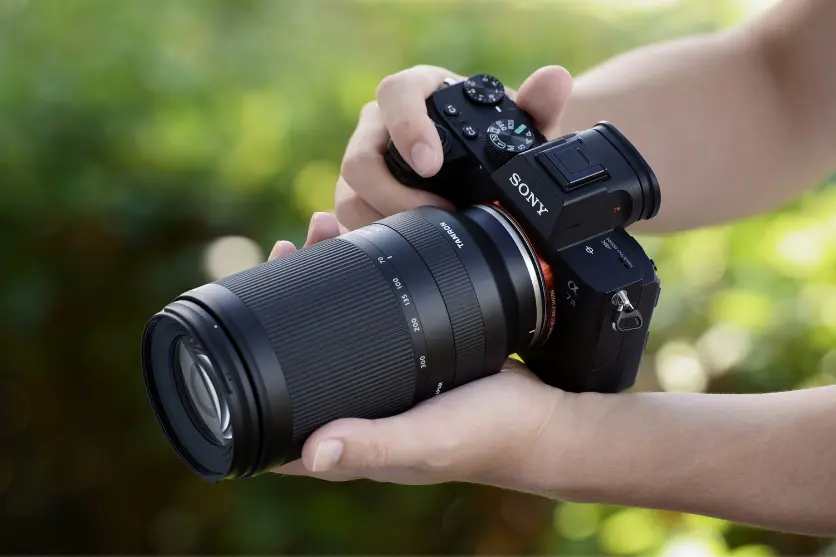
One of the unique points of a sports day is that you cannot shoot close to children. Especially during competitions such as running races, there are many situations where you are forced to take pictures from a distance. In such cases, smartphones cannot capture large images of children, and excessive zooming may degrade image quality. For this reason, we recommend the use of interchangeable-lens cameras with a choice of zoom lenses for photographing athletic events. Using an all-in-one or telephoto zoom lens will allow you to capture children’s expressions in large, clear, and vivid images.
On the other hand, it is not enough to use any single-lens reflex camera. A particularly important point is the choice of lens. Beginners of interchangeable-lens camera often use standard zoom lenses that come in lens kits and other accessories.
However, a standard zoom lens in general does not allow for sufficient close-ups, and in many cases, it is not possible to capture distant subjects as you would like. When shooting from a distance, such as at an athletic meet, it is best to use an all-in-one zoom lens or telephoto zoom lens.
All-in-one zoom Lenses
An all-in-one zoom lens is a lens that allows a wide range of focal lengths. Specifically, an all-in-one zoom lens is a lens that covers a wide range of focal lengths, from a wide-angle range of approximately 35 mm or less to a telephoto range of approximately 85 mm or more. Specific examples include 28-200 mm for full-size lenses and 18-300 mm for APS-C size lenses.
With an all-in-one zoom lens, there is no need to change lenses to wide-angle or telephoto lenses, and a single lens is versatile enough to handle everything from close-ups of children to landscape photography that captures the entire ground. The advantage of this is that you can wait for the moment you want to take the shot and release the shutter, preventing mistakes such as “I missed the decisive scene while I was changing lenses.
Furthermore, since there is no need to carry multiple lenses, the lens is convenient to carry, which is a nice feature for photographing events such as sports festivals, where luggage can be bulky.
Telephoto Lenses
Telephoto lenses have a focal length of 85 mm or longer and are suitable for taking large pictures of distant subjects. At sports festivals, photographers are often forced to take pictures at a distance from children for reasons of location and management. Telephoto lenses are useful in such situations.
With a telephoto lens, you can capture close-ups of children’s expressions and whole bodies even when shooting from a distance. It is also a lens that excels at taking pictures with a blurred effect, so you will be able to take pictures that bring out the main subject in a way that is typical of interchangeable-lens cameras.
[Preparation for photography] Check the settings of the camera body
The basic setting for taking pictures at a sports day is the settings of the camera itself. Adjust the shooting mode, shutter speed, ISO sensitivity, and other settings to get the picture you want. The following is an explanation of each of these points.
Shooting Mode
There are various shooting modes available on the camera itself. If you are not used to shooting with an interchangeable-lens camera, it is a good idea to select “Sports” from the scene-specific shooting modes. In Sports mode, the camera automatically adjusts the shutter speed for optimum performance, allowing you to capture the moment of a moving subject. If the camera you are using does not have a sports mode, you should use the shutter priority mode (see next item).
Once you have become accustomed to handling your interchangeable-lens camera, try shooting in shutter priority mode. In shutter priority mode, the f-number (aperture value) is automatically adjusted for optimum brightness by setting the shutter speed to a desired value. Depending on the setting, you can expand the range of expression, and also be flexible to change the environment, such as dark or cloudy weather.
Shutter Speed
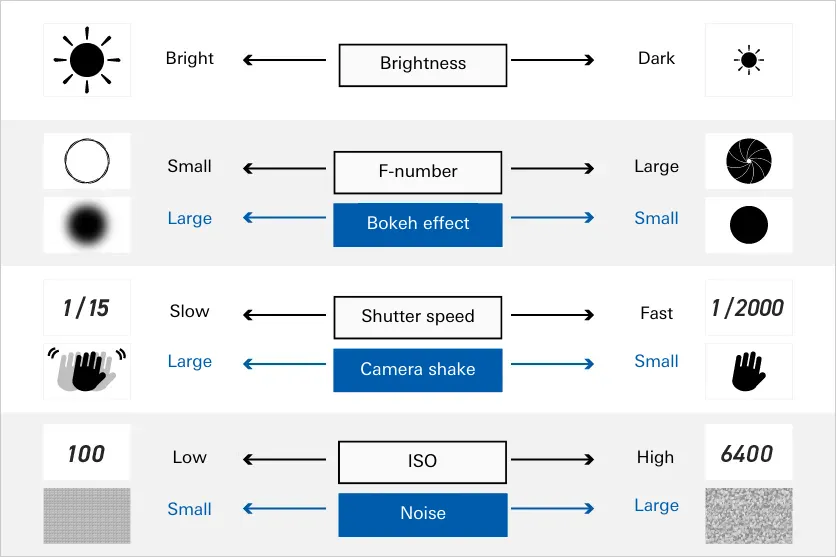
Shutter speed is the amount of time the camera shutter is open. By changing the shutter speed, you can change the way moving subjects appear. Specifically, a fast shutter speed shortens the time it takes to capture a subject, allowing you to capture an instantaneous image of a moving subject.
On the other hand, a slower shutter speed takes longer to capture a subject, resulting in blurred images of moving subjects. Therefore, a fast shutter speed is the basic rule for athletic events where there is a lot of movement. As a rule of thumb, a shutter speed of around 1/1000 second or faster is recommended.
However, a fast shutter speed means that less light can be captured by the sensor of the interchangeable-lens camera. This is not a problem on sunny days, but if the light level is low, such as on cloudy days or in the shade, the picture will be dark, in which case it is best to set the shutter speed slightly slower.
ISO Sensitivity
ISO sensitivity is a measure of how much light is amplified as it enters the camera’s sensor, the higher the ISO sensitivity, the brighter the picture. ISO sensitivity is often set to auto, but a good rule of thumb is to use ISO sensitivity between 200 and 400 on a sunny day and between 800 and 1600 (or higher) on a cloudy day.
F-number (aperture value)
The F-number (aperture value) is an indicator of the amount of light that enters the camera’s sensor through the lens.
A smaller F-number opens the aperture and increases the amount of light let in, resulting in brighter pictures. On the other hand, a larger F-number narrows the aperture and lets in less light, resulting in a darker picture overall. The F-number also affects the out-of-focus effect of the photo: a small F-number produces a larger out-of-focus effect, while a large F-number produces a smaller out-of-focus effect.
When using sports mode or shutter priority mode to take pictures at an athletic event, the F-number adjustment is left to the auto mode. When adjusting manually, generally, setting the F-number from F4 to around F8 will make it easier to clearly capture the expressions of moving children.
AF (Auto Focus)
AF (Auto Focus) is a function in which the camera automatically focuses on the subject. When shooting at an athletic event, it is a good idea to set the AF setting to continuous AF mode. Continuous AF mode allows the camera to keep the subject in focus as long as the shutter release is pressed halfway down, making it ideal for photographing moving subjects. It is especially useful for fast-moving scenes such as running races and relays at sports festivals.
Image Stabilization
When using a telephoto lens or shooting hand-held, camera shake tends to occur. For this reason, it is recommended to turn on image stabilization on the camera body and lens. Some products have a framing-oriented image stabilization mode that is suitable for irregularly moving subjects such as sports. Check this when shooting.
How to photograph different events
At sports festivals, there are many scenes to photograph, such as running races, relays, and team events. However, the tips for taking pictures vary depending on the event, so it is important to respond according to the situation. Here are some tips for shooting different scenes at athletic events.
Before the show! Be sure to check the photography rules and program
Before you start preparing for the photo shoot, be sure to check the precautions and programs from the school/school. The letter distributed in advance will list the areas in the school and school grounds where photography is prohibited, as well as the rules regarding photography. It is essential to check in advance to ensure that you will behave in a manner that is appropriate.
In addition, to improve the quality of your photos, pay attention to your positioning. To ensure that the photos are composed exactly as you envisioned, it is a good idea to confirm the day’s program, the position of the front of the building, where the children will stand, and the goal position for the running race (footrace).
Please note that the day of the Sports Day will be crowded with many parents and families. It is highly unlikely that you will be able to take pictures in the front row because of the crowding in the available shooting areas, but if you prepare an all-in-one zoom lens or telephoto lens, you can rest assured that you will be able to take good pictures even from a distance.
Races and relays
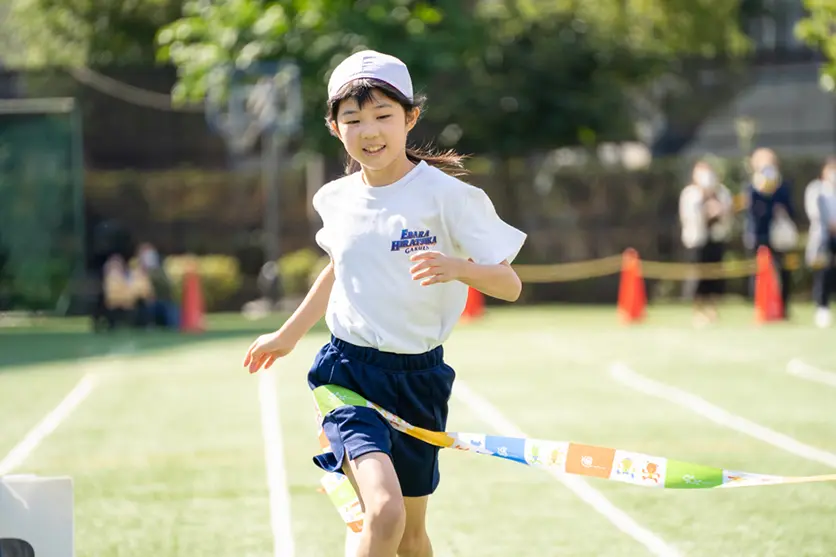
TAMRON 70-300mm F4.5-6.3 (Model A047) Focal length: 300mm Exposure: F/6.3 Shutter Speed: 1/1600sec ISO: 1000
When photographing a running race or relay, the composition of the shot will depend on the location. For a short-distance race, the moment of the start or finish line, and for a relay, the moment of the curve will make an impressive photograph. However, it is difficult to find a good shooting position. Even if you cannot secure a front row position, you can take a large picture by using a telephoto lens (or the telephoto side of an all-in-one zoom lens) from a location where you can capture the front of the child.
Another point to note is that moving the camera too much can cause camera shake, so it is best to wait for a shutter release opportunity without changing the camera position as much as possible. Set the shutter speed to a high speed (e.g., 1/000 or faster) and press the shutter release button halfway down to focus on the subject while continuing to capture the running child in the frame. When the child gets closer and larger, take a continuous shot.
Dance, cheer competition, and performance

TAMRON 70-300mm F4.5-6.3 (Model A047) Focal length: 300mm Exposure: F/6.3 Shutter Speed: 1/1600sec ISO: 1000
In scenes of dancing, cheering contests, and acting, it can be somewhat difficult to photograph the children because their positions change so fluidly. If there is a time when they stay in a certain place, it is easier to shoot at that moment. Therefore, if possible, it is a good idea to talk to the children in advance and get some idea of their moving positions from start to finish before shooting.
It is also important to adjust the AF to focus on my child’s expression with pinpoint accuracy among many children. If it is difficult to get a close-up of just my child, one option is to shoot with a wider angle of view and crop the image later.
Group events such as ball tossing, giant ball rolling, and tug-of-war
In group events such as ball tossing, giant ball rolling, and tug-of-war, children tend to jump and move up, down, left, and right. To take more beautiful pictures, it is recommended to take a series of pictures at a high shutter speed. In the case of a ball toss, the moment the ball is picked up and thrown, and in the case of a giant ball toss or tug-of-war, the moment a child’s face tightens up after putting in a lot of effort are good photo opportunities. By taking a series of consecutive shots, you can capture these dynamic moments without missing a single shot.
We also recommend using the wide-angle side to capture the entire scene to record the atmosphere unique to team events.
Group events such as ball tossing, giant ball rolling, and tug-of-war
In addition to capturing the competition, there are many memorable scenes outside of the competition at athletic meets. For example, you can capture the tense or excited expressions on the children’s faces when they are waiting for their cue, or when they are chatting with their friends. Even when children are far away, a telephoto lens makes it easier to capture such scenes.
A standard lens, rather than a telephoto lens, is easier to use when children are nearby, such as during lunch, or when taking pictures of scenery at a venue. If you use an all-in-one zoom lens, you can flexibly change the angle of view and do not need to change lenses. In addition, a lens with a short minimum focus distance will allow you to take pictures freely even in a narrow leisure seat where the range of movement is limited.
Direction of light and angle are also important
The direction of light, position, and angle are also important factors in taking impressive photographs. From here, we will explain the direction, position and angle of the light.
Direction of light
There are several types of light direction, including forward light, backlight, and side light. The impression of the subject will vary depending on the direction of the light.
When photographing people, backlighting tends to darken their expressions, so it is best to use forward light, such as from the front or at an angle, as much as possible. In addition, side lighting can be used to express the shadows of facial expressions and create a dramatic atmosphere. Especially toward the end of the program, as the evening approaches, an emotional atmosphere can be created.
About positions and angles
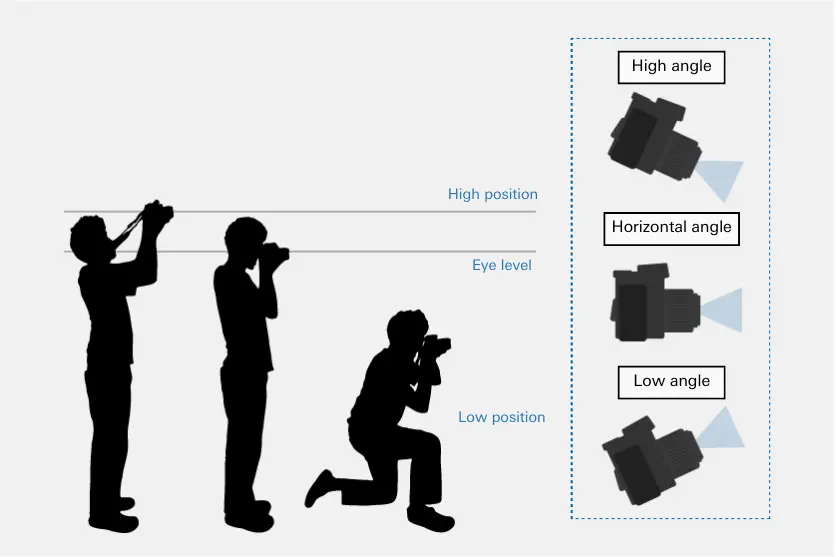
Position refers to the position from which the camera is held. When shooting from a position higher than eye level, it is called the high position, and when shooting from a position lower than the waist, it is called the low position. When photographing children, it is best to hold the camera in the low position, i.e., at the child’s eye level, to capture their facial expressions and make it easier to take dynamic pictures.
Angle, on the other hand, refers to the angle at which the camera is pointed. When the camera is pointed up, it is called a low angle, and when it is pointed down, it is called a high angle. Photographing from a low position or low angle makes the child appear larger and more powerful. Since changing positions and angles can change the impression of a photo, it is interesting to try shooting from various angles.
Points for taking pictures indoors in bad weather
In the event of inclement weather, some kindergartens and schools may hold their athletic events indoors. When taking pictures indoors, such as in a gymnasium, it is difficult for light to penetrate the room, unlike outside, so the pictures are likely to be dark. Therefore, it is necessary to take measures to increase the exposure.
Setting a slightly slower shutter speed and increasing the ISO sensitivity are good countermeasures; using a smaller f-number and adding exposure compensation can also be effective. Avoid using flash, which interferes with competition and management, darkens the background of the subject, and creates unnatural shadows.
In addition, indoor viewing spaces are limited, so the number of places where you can take pictures may be even more restricted. We recommend the use of a telephoto lens so that you can capture the child’s expression from a distance.
Please be considerate when taking pictures at athletic meets
As mentioned above, some kindergartens and schools may have specific areas where photography is allowed, or may have prohibitions or precautions regarding photography. It is important to check the notices distributed in advance to ensure that you follow the rules.
In addition to following the rules, it is also important to be respectful of other parents. At a minimum, please observe the following manners: when your child’s group finishes, switch to the next group, and do not disturb the viewers or photographers in the back of the room. It is important to put yourself in the shoes of the other parents and make sure that both parties can feel comfortable taking pictures.
What lenses are suitable for photographing at athletic events?
There are many different types of camera lenses, but it is important to use a lens that is suitable for shooting at sports days. Here are some tips for choosing the right lens for shooting at sports festivals.
Focal length
As mentioned above, telephoto lenses are best suited for sports days because the distance between you and the children is greater. A good rule of thumb for focal length is to use a lens that covers a range of 200mm to 300mm at the telephoto end to ensure that you can capture even distant subjects. An all-in-one zoom lens can cover not only the telephoto range but also the wide-angle range, making it possible to shoot all kinds of scenes with a single lens.
Size and weight
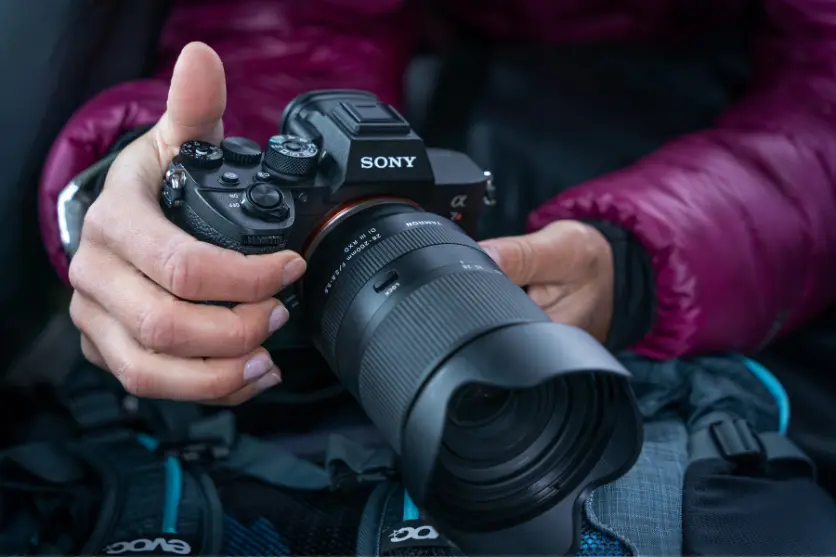
Since you will often carry a camera around with you to take pictures at athletic events, you will want to choose a lightweight and compact type. Lightweight lenses are less tiring and reduce camera shake even when shooting hand-held. In addition, since you will be carrying a lot of baggage at an athletic meet, a compact lens will not be bulky. In this regard, we recommend all-in-one zoom lenses, which eliminate the need to carry several lenses.
Maximum aperture F-number
The maximum aperture F-number refers to the F value with the aperture at its widest setting. A lens with a small maximum aperture F-number allows more light to enter the lens, making it easier to take bright pictures when shooting indoors or in other dark places. Therefore, a lens with a small maximum aperture F-number will allow you to take more flexible photos of athletic events.
AF performance
Since many athletic events involve shooting scenes with moving subjects, it is important to make sure that the camera can smoothly focus on moving subjects. It is also important to check that the AF system can track moving subjects without stress. If the camera will be used for quiet scenes such as opening or closing ceremonies, or even for video recording, the quietness of the AF is also an important factor to check.
Image stabilization mechanism
Telephoto lenses (or photography using the telephoto side) are prone to noticeable camera shake, so choose a lens that has an image stabilization mechanism in the lens. Although a tripod is often used when shooting with a telephoto lens, it may not always be available at an athletic event. Therefore, the availability of an image stabilization mechanism becomes even more important. In terms of functionality, the ability to adjust the amount of image stabilization can broaden the range of expression in a variety of shooting situations, not limited to athletic events.
Enjoy photographing at sports festivals by keeping the tips of photography in mind!
Since children are often photographed from a distance at sports festivals, the use of all-in-one zoom lenses or telephoto zoom lenses is recommended. In addition to lens selection, camera settings such as shutter speed and ISO sensitivity are also important. Observe the rules and manners of photography, and be sure to capture your child’s growth before you know it.
Lens Featured in this Impression

28-200mm F/2.8-5.6 Di III RXD (Model A071)
Tamron has distilled all the technical capabilities and know-how amassed over the last 28 years in its development of all-in-one zoom lenses into the creation of this 28-200mm F/2.8-5.6 Di III RXD (Model A071), designed exclusively. The lens has a large maximum aperture of F2.8 at 28mm wide end, which represents a world’s first* for all-in-one zoom lenses, and delivers high-level performance across the entire zoom range, from the 28mm wide-angle end to 200mm telephoto.
Learn more
28-300mm F/4-7.1 Di III VC VXD (Model A074)
28-300mm F/4-7.1 Di III VC VXD (Model A074) is a compact and versatile all-in-one 10.7x zoom lens for Sony E-mount. The lens boasts class-leading high image quality, and is equipped with high-speed AF VXD and VC. Go from wide-angle to long telephoto in an instant and capture every moment of the world around you.
Learn more
50-300mm F/4.5-6.3 Di III VC VXD (Model A069)
50-300mm F/4.5-6.3 Di III VC VXD (Model A069) is a 6x telephoto zoom lens for Sony E-mount that delivers outstanding convenience and image quality. Discover the groundbreaking capabilities of a 300mm telephoto zoom that starts from 50mm at the wide end.
Learn more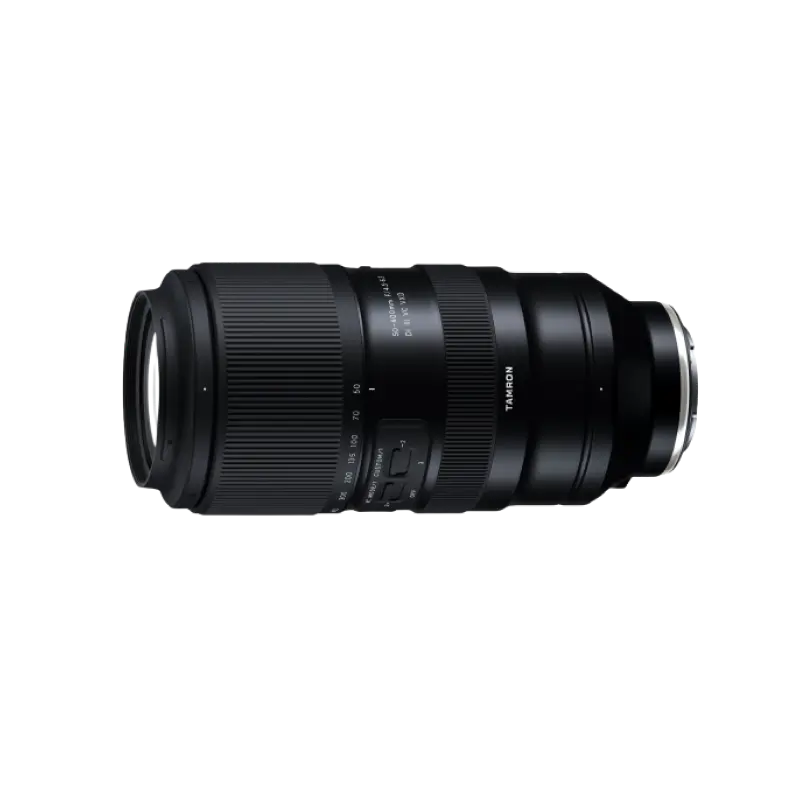
50-400mm F/4.5-6.3 Di III VC VXD (Model A067)
The 50-400mm F/4.5-6.3 Di III VC VXD (Model A067) is an ultra-telephoto zoom lens with an 8x zoom starting at 50mm at the wide-angle end and compatible with full-frame mirrorless cameras. The lens delivers uncompromised high image quality over the entire 50-400mm focal length range, yet is as compact and lightweight as a 100-400mm class lens. Equipped with the VXD mechanism and the VC mechanism, the lens can quickly focus on the subject's movement when shooting sports and wild birds. The 50-400mm F4.5-6.3 VC is a new ultra-telephoto zoom lens that combines unparalleled image quality and mobility.
Learn more
70-180mm F/2.8 Di III VC VXD G2 (Model A065)
70-180mm F/2.8 Di III VC VXD G2 (Model A065) has evolved to G2 level.This is the world’s smallest and lightest, fast-aperture telephoto zoom lens for Sony E-mount and Nikon Z mount with astounding portability and superb image quality.
Learn more

